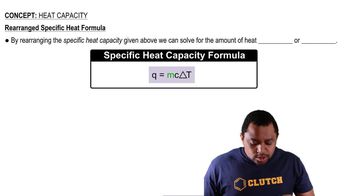Here are the essential concepts you must grasp in order to answer the question correctly.
First-Order Reactions
First-order reactions are chemical reactions where the rate is directly proportional to the concentration of one reactant. In this case, the decomposition of N2O5 follows first-order kinetics, meaning that the rate constant (k) is used to determine how quickly the reactant is consumed over time. The integrated rate law for a first-order reaction can be used to calculate the concentration of reactants at any given time.
Recommended video:
Rate Constant (k)
The rate constant (k) is a proportionality factor in the rate equation that is specific to a particular reaction at a given temperature. For first-order reactions, k has units of s^-1, indicating how fast the reaction proceeds. In this question, the rate constant of 1.7 * 10^-3 s^-1 is crucial for calculating the amount of N2O5 decomposed over the specified reaction time of 10.0 minutes.
Recommended video:
Heat Absorption in Reactions
The total amount of heat absorbed or released during a chemical reaction is related to the enthalpy change (ΔH) of the reaction. In this context, the heat absorbed can be calculated using the stoichiometry of the reaction and the amount of reactant consumed. Understanding how to relate the change in concentration of N2O5 to the heat absorbed is essential for solving the problem presented.
Recommended video:




